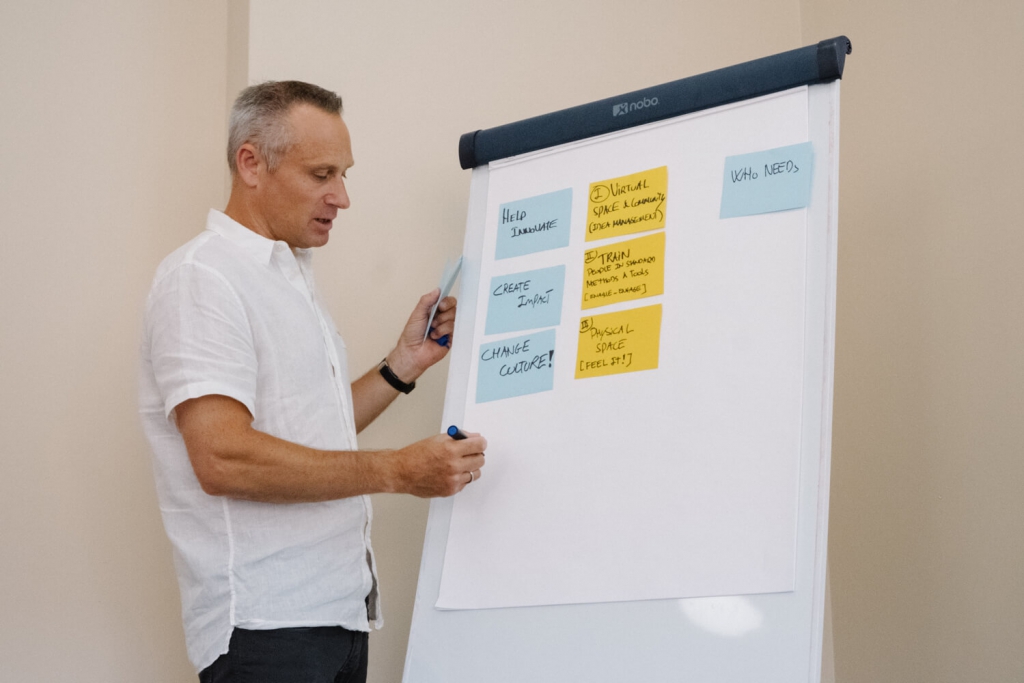
Transparency, Recognition And Self-Appointed Teams: Fostering Employee-Driven Innovation At Scale
Most companies have a large and powerful source for innovation that, to a large extent, is left unused – their employees.
Written by
April 29, 2022
Tapping into your employees’ collective genius can create a potent pipeline that delivers growth, and it also raises engagement within your company.
Looking inward to get started is not only the ‘right’ thing to do- it also produces more solid solutions that are easier to implement and realize. And mobilizing and engaging employees to share their ideas creates growth and better financial performance for corporations. A McKinsey research study shows that companies that engage employees in innovation activities report up to 2.4x better financial results.
Of course, there’s much more to employee-driven innovation than just opening up a (digital) idea box. We spoke with Morten Benn, Partner at Nosco, with 20+ years of experience in the industry, to understand the core elements of fostering employee-driven innovation at scale.
Thousands of Employees “Cracking Hard Nuts”
Employees are the intellectual capital of a company. They are the ones that most likely know the company’s products and markets better than anyone else. For a small company, it’s natural to involve employees in solving the company’s most critical challenges. It’s natural to ask the employees if they have good ideas for increasing growth or efficiency.
However, the larger the size of the company, the more complex it is perceived to ask everyone. Indeed, distance from top to bottom increases, and the intellectual capital becomes more distributed around the globe. And if there is no infrastructure to tap into this abundance of knowledge, it’s almost impossible to know what the company really knows.
That’s why, according to Morten, it’s a big mistake not to ask employees, especially in large organizations. Digitalization has solved the problem of engaging with all of them. Nosco’s platform makes it easy to ask thousands of employees for ideas and to involve middle managers and internal experts to evaluate and choose the ideas to invest in, without drowning in answers and arduous, time-consuming processes.
Some might argue that ideas coming from employees are too close to the core, and as such, there’s not much value in them- but Morten has a different view.
“I really do not like the popular use of the term ‘disruptive’ ideas. It is widely misused. In my experience, a lot of great and valuable innovation has come from close to the core ideas. One of my clients with 20+ years of R&D experience once said that increasing the speed of one production component by 50% was the most valuable idea he had ever worked on. And it was also the hardest nut to crack”.
Morten believes that “working on cracking hard nuts” is, in essence, what Clayton Christensen was aiming at in his famous HBR article about the theory of disruptive innovation. In short, typically, ideas close to the core are far more profitable to be realized, and they may also potentially have a real, significant impact. Whereas ideas outside the capabilities or too far away from the core are way more likely to fail, they are way more difficult to implement or validate, and they often require a lot more investment. Disruptive innovation is both more risky and expensive.
At Nosco, they call new ideas ‘transformative’ if they have the power to reshape and transform the current business. And, more often than not, what companies need is indeed to transform their business, not disrupt it.
Running global innovation challenges or idea campaigns are also effective in supporting your company’s transformation in other ways.
Typically, at the “other side of the transformation”, companies want to have developed certain capabilities. They may not know that many people with the required skills are already in the company. They may have different roles than one might expect, or in other parts of the organization than internal recruitment would look, and as such, leaders don’t know about them, because there’s no effective way to identify these people. Through innovation challenges and idea campaigns, employees with future-ready skills sets supporting your company’s transformation will become visible.
What Are The Parameters For Success?
You never know what and where the best ideas are in your organization, until you ask everyone. Yet it might not always be a good option to just involve anyone for your next challenge or campaign.
To tap into the abundance of knowledge and ideas efficiently, Morten highlights what he has found to be parameters for success:
1. Build a digital infrastructure for innovation.It needs to be collaborative, transparent, and offer a simple and appealing user experience.
2. Solve an important business challenge and define it narrowly. There’s no use in asking broad questions like “what should our company work on next?”, even though many people might have all kinds of answers. The more relevant a topic, the greater the engagement will be around it. Also, provide access to information so that they have a clear idea of what is essential for the company and why it is so.
3. Get the attention of as many employees as possible. Like many things, this is a numbers game so the more people you involve, the higher the chances of success at the end.
4. Design your process so that executives, middle managers, and subject matter experts can easily contribute, with minimal use of their time. When leadership is engaged, this gives relevance and importance to the call for ideas, as employees may feel a greater urge to come up with good answers. Over his career, Morten has noticed that top management often asks for innovation, while the middle management is disconnected and disengaged.
Like it or not, this is how organizations are designed- the middle management is responsible for running the day-to-day business and as such, is measured on how that’s performing, not on innovation. But they manage crucial resources and, as innovation is a resource game, you need to engage and connect the middle management in your innovation challenges and idea campaigns.
5. Ensure that the best ideas go into a fast incubation process for validation. Morten recommends agreeing on a fixed three-month incubator program with your business challenge owner, before even running the idea campaign.
6. Communicate results and benefits widely and consistently.
7. Do it again and again! This way, you start building and fostering an internal ecosystem of intrapreneurs.
Transparency, Recognition and Self-Appointed Teams
Of course, the most critical success factor for all of this to work are the employees and their willingness to put forward their ideas.
We all know too many stories of idea campaigns or hackathons where a lot of time and energy was spent exploring problems and identifying solutions, but once the campaign or event was over, the employees that contributed or participated never heard back about all those great ideas they worked. Guess what happens if you ask for their involvement next time…
Or maybe, on the flipside, the follow up from such campaign or event was that an idea was chosen as winner, and as a reward, the individual(s) originally proposing that idea were asked to start working on that idea in their own time, on top of their more than full-time day jobs, with no extra time, basic resources and or other support offered. Guess how winning the competition feels then…
So, how to avoid the disappointment or the frustration of either scenario?
Morten recogrnizes those scenarios, and adds that also here, the platform you use for your campaign should support properly managing expectations and communication, like the Nosco platform does. You will have put in objective evaluation criteria beforehand, so they have been clear all along, and once all ideas have come in, you can easily rate ideas and decide about progressing them based on those criteria. Through their platform for example, if an idea doesn’t make it, you can still add feedback why that’s the case and what other next steps could be. Maybe the idea could help improving some internal process, or it could be a great new feature in the existing tech stack, so there’s some merit to them, but they’re just not in scope for your campaign.
You can easily add that feedback and thank employees. And that’s enough- they will understand and accept this outcome, and would be happy to contribute a next time
Morten remembers a shift-worker in a factory in Czech Republic. The idea he submitted in itself didn’t appear to help solving the challenge as put forward, but the illustrations he used to make the case were great, making a complex issue look simple. As a follow up, he was invited to the HQ R&D Centre for a debrief with business management, which eventually informed several improvements in internal processes. Knowing about the exposure their colleague got from his idea submission, many factory workers got engaged in the next campaign.
Yet maybe even more important for keeping employees engaged in innovation is their ability to create what Mortens calls “self-appointed teams”, supported by the Nosco platform. This has proven to be an effective way to transfer the power of entrepreneurs – pursuing their own idea with “fire in their eyes” – to intrapreneurs within the company.
Essentially, it’s like a dating app for ideas, where people interested in working on specific ideas can connect, share and collaborate across the organization, and any employee can apply to become a team member for the projects in ideation and incubation stages.
This helps to create more diverse teams, especially mixing up senior and newer employees – these always perform the best because the former have the network and the experience of how the organization works, and the latter fresh energy and new perspectives.
For Morten, on top of building the proper digital infrastructure, enabling self-appointed teams is by far the most powerful thing a corporation can do to foster employee-driven innovation.
What’s The Role Of The Innovation Function?
Now, you might ask- if employees come up with new ideas, and even form teams to lead those ideas through an incubation program, what’s left for the innovation function?
Morten has a clear view: the role of the innovation function is to make innovation everyone’s business.
“As innovation function, we define the “rules” regarding how to create an engaging call for ideas, how ideas are validated, and what happens after the campaigns, and thus facilitate the end to end innovation process for the whole company. The role of the innovation function, the innovation team, and the innovation department is to stimulate and orchestrate this engagement by giving directions, providing working forms, and facilitating it. The innovation function has the validation methods, tools, and criteria, while the company owns the ideas and harvests the benefits.
When an innovation function of a few people manages to support thousands of employees around the world in filling their business unit’s innovation pipeline with highly investable ideas, that’s when we call it innovation at scale”, Morten concludes.

Morten has more than 20 years of experience as a management consultant, helping Implement Consulting Group grow to the largest independent consultancy in Scandinavia. An entrepreneur at heart, he has started and grown several successful businesses and now serves as a board member to numerous start-ups.
MORE ARTICLES



